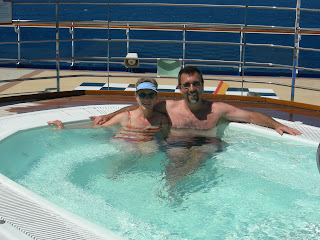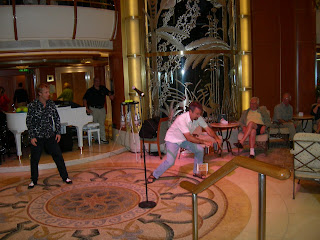
With a couple of days on the open seas, we thought that this would be a good time to talk a little bit about our "Cruising" experience.
This shot goes back to embarkation in Valparaiso. We didn't really know what to expect from a cruise but . . . how bad could it be!!

Anchors aweigh! When we booked the cruise, we had the choice of three different types of accommodations: a suite with a balcony, an outside suite with a window, or an inside suite with no window. A balcony, or even a window would have been very nice . . . but the inside room was just fine, especially for those on a tight budget! On our TV, we could dial up the camera on the ship's bridge for a look at the outside world. Next best thing to a window!

You've seen this picture before, but this time, notice the travel mug in my hand. Almost all beverages on board, including pop, came with a hefty charge and mandatory 15% tip. Again with the budget in mind, we boarded with some fine Chilean wine of our own and used the travel mugs as a not so clever disguise. Doing that is against the Princess Cruise Line rules and we know that we didn't fool anyone. Thankfully, we weren't forced to walk the plank, or left on a deserted island.

On the open seas, with no land in sight, I often wondered how far away the horizon was. Despite my best efforts, I was not able to find out. My best guess is about 10 miles. We both enjoyed being on deck and looking out over the vast ocean, especially when there were a half dozen Albatross soaring behind the ship! As was the case with the Giant Petrels, we were hundreds of miles from shore.



This shot gives you an idea of how calm the ocean was. For the vast majority of our time on board, the motion of the boat was present, but insignificant. There were times, though, when it felt like we had had too much of that fine Chilean wine as we weaved our way down the hallways. I assure you that it WAS the roll of the ship, and not the wine . . . most of the time!

This pool was located near the spa at the bow of the ship. We didn't try this one but it was designed so that it felt like you would be swimming against the current. The spa services were provided at a cost, but there was a well equipped gym and a sauna that were free.

Speaking of pools, this was the indoor pool on level 14, at about mid-ship.

So far I have mentioned that some things on board were free while others were not. Eating at the 24-hour buffet was both free, and delicious, as was the International Cafe where we often had lunch. There were other upscale restaurants where you could pay an extra $20 per person to eat but . . .
Speaking of eating, here is the buffet . . .

. . . and the adjoining dining room. In the background you can see windows to the outside. We were almost always able to get a window seat and only had to share a table on 2 or 3 occasions.
The food was always varied, plentiful and tasty with a different culinary theme each day.

So . . . we had a good bed, a roof over our head, and were well fed . . . but what would we do to keep ourselves amused between ports of call? There was no end of entertainment choices both day and night. First of all, the entertainment was free. During the day, there were trivia contests, informational lectures, movies, dance lessons and more.

We can now line dance . . . sort of! The Cha-Cha however was beyond my middle aged white man ability! Here's Charlene "busting a move" with some of the other passengers learning how to line dance.

We also spent some time playing ping pong.

The Ping Pong tables overlooked the indoor pool.

And after a workout with the rackets, a dip in the hot tub was often squeezed into the schedule!

We came to refer to this pool as "Ours" as we more often than not, we were the only ones in it!

The pool was outdoors on deck 14 and had a cold pool next to it. If you look closely, you will see a dark glass tunnel running up toward the back of the ship. The hot tub was just below the tunnel.

And speaking of the tunnel, it led to the top level at the rear of the ship. That top level (level 17) was a glassed in night club called Skywalkers. We did dance one night . . . but not the Cha Cha!

Night time entertainment included live, professional stage presentations on each of the two theatrical stages. Throughout the cruise there were musicals, comedians, jugglers, etc.
There was also a live band and a dance floor at one of the bars and much more. Part of that "much more" was "Movies Under the Stars". . . sort of a luxury version of the drive-in!

I've included this shot just to show the screen used for showing movies at night.

The focal point of the ship was the plaza. It was mid ship and was open from decks 5, 6 and 7.

There were often musicians playing here throughout the day, but sometimes, there were previews of the evening performances.

That's what was going on when I got lassoed into being part of the juggler's show!

This clip will give you a better idea of the overall plaza area.
There were ample opportunities on board to spend your cash if you were so inclined. Actually, there was no cash trading hands. All of the transactions were handled by an electronic card and ultimately ended up on our credit card. That card was also used to keep track of our coming and going from the ship at each port of call. There were stores selling everything from jewelry to stuffed animals. There were also official photographers to take your picture in every setting imaginable and at every port of call. Those photos were, of course, available for purchase afterward. That being said, it was possible to live very nicely on board and spend nothing more than the original ticket price. Our largest expense was the two organized shore excursions. They were expensive, but both were excellent!
Another interesting past time on board was to check the crew's name tags. The tags contained their country of origin, and the world was well represented! We met people from Canada, England, Australia, Russia, Romania, Thailand, Philippines, Chile, Peru, Argentina, Ukraine, China . . . While there were dozens of languages available, English was required to gain employment on the ship.
With the help of an innocent bystander, we took our own "portrait".

Overall, the ship was quite remarkable, and the experience was unforgettable. We certainly don't see another cruise in the near future but would quickly recommend it to anyone who was thinking about it.
For those interested in geography, some cruise facts are listed below.

Valparaiso to Puerto Montt 653 Nautical miles
Puerto Montt to Amalia 712 Nautical miles
Amalia to Punta Arenas 358 Nautical miles
Punta Arenas to Ushuaia 211 Nautical miles
Ushuaia to Cape Horn 135 Nautical miles
Cape Horn to Stanley 454 Nautical miles
Stanley to Montevideo 1025 Nautical miles
Montevideo to Buenos Aires 138 Nautical miles
Total distance = 3668 Nautical miles
Depart Valparaiso - Monday February 2, 18:00
Arrive Buenos Aires - Saturday, February 14, 8:00
Soon we will be docking in Montevideo. Any guesses as to which country we will be in??
Until then,
Amor,
Norm y Charlene












































